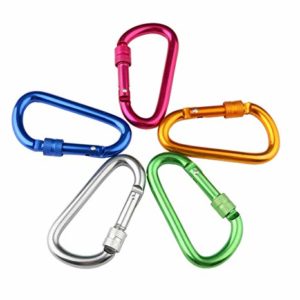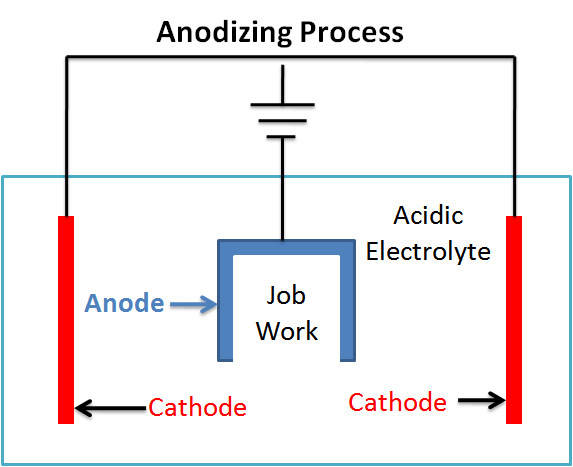Pure aluminum forms a 1 to 10 nm thick oxide layer due to the reaction from oxygen. This oxide layer prevents aluminum from corrosion and wear. The higher the thickness of the oxide layer, the more will be the corrosion resistance.
Therefore Anodizing Process increases oxide layer thickness to improve aluminum and other non-ferrous alloy corrosion resistance.
What is Anodizing?

Anodizing is an electrochemical conversion process for producing variable oxide layers thickness on aluminum and other non-ferrous metals such as magnesium and titanium. Oxide layer thickness can vary from 1 to 80µm.
The oxide layer improves material corrosion resistance and wear. Chromate conversion coating is used as a primary coat to improve corrosion resistance. Anodized aluminum has a variety of applications across architectural, consumer electronics, and aerospace industries.
How to Anodize Aluminum?

The part is submerged in an electrolytic solution (acidic) bath with a cathode during aluminum anodizing. During anodizing, the metal Part works as an anode.
When a current is passed through an electrolytic solution, the cathode releases the hydrogen and oxygen forms on the anode surface. In this way, the metal oxide film forms on the anode surface. Experts recommend performing machining, drilling, and welding operations before anodizing.
Corrosion Resistance
Anodizing improves surface resistance to wear and corrosion. Corrosion resistance depends on the type of coating and its thickness.
You can achieve salt spray resistance of up to 336 hours using anodizing process. Anodizing aluminum also protects the material against galling. Galling is wear caused by friction.
Types of Anodizing
Following types of anodizing processes are available according to coating thickness and color requirements.
Type-I Chromic Acid Anodizing
Type-1 chromic acid anodizing color varies from light gray to dark olive depending on the type of aluminum alloy used. Its application includes:
- Achieve higher corrosion resistance for aerospace industry parts.
- Primary coat for powder coating.
Type-II Sulfuric Acid Anodizing
It involves immersing the aluminum in sulfuric acid solution and passing a current through it. We can classify it into two classes.
- Class-1: Un-dyed anodized finish
- Class-2: Dyed anodized finish (various color options)
Type-II Finish Representation
- Red Anodized (MIL-A-8625, Type-II, Class 2)
Type-III Hard Anodizing
It involves immersing the aluminum in sulfuric acid solution at low temperatures and high voltages. As a result, hard wear and abrasion-resistant aluminum oxides layer is produced. It can be further classified into two classes.
- Class-1: produces a hard clear anodize layer.
- Class-2: produces a hard Black anodize layer
Type-III Finish Representation:
- Clear Hard Anodized (MIL-A-8625, Type-III, Class 1)
- Black Hard Anodized (MIL-A-8625, Type-III, Class 2)
Type-I vs Type-II vs Type-III Anodizing
| Properties | Type-I (Chromic Acid) | Type-II (Sulphuric Acid) | Type-III (Hard Anodize) |
|---|---|---|---|
| Applications | Decorative | Decorative | Corrosion Resistance |
| Corrosion Resistance | Good | Good | Excellent |
| Coating Thickness | 0.08–0.25 µm | 2.54–25 µm | 12.7–80 µm |
| Wear Resistance | Poor | Moderate | Excellent |
| Porosity | Low | Moderate to High | High |
| Environment Friendly | No | Yes | Yes |
| Appearance | Primary Coat | Clear or Dyed | Hard Clear or Hard Black |
Advantages of Anodizing
Anodizing process has the following advantages compared to other metal finishing operations.
- Improved corrosion and wear resistance.
- Good aesthetic
- Can achieve a variety of colors.
- Clear finish options are also available.
- Low cost compared to powder coating.
- Extremely durable, hard, abrasion-resistant, and long-lasting.
- Recyclable
To sum up, aluminum is anodized to improve corrosion, wear, impact resistance, and aesthetics of a product at a comparatively low cost.
We will keep updating more information on aluminum and other non-ferrous metal anodizing processes. Add your suggestions, comments, or questions on anodizing aluminum and other non-ferrous metals in the comment box. We suggest you also read this article on What is galvanic corrosion and how to prevent it?

I am in need of Anodizing on Titanium material, Please suggests Process for Pretreatment and anodizing on Titanium base material.